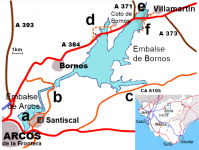foresttwitcher
Virtually unknown member

My previous two visits to southern Spain had been at different times in the year (October & April) so I had missed out on a couple of late arriving breeding migrants. Therefore this trip was planned to try for three such targets and in the hope getting a sighting of a previously heard only species - so the habitats visited were perhaps a bit more limited than usual.
Flights were booked direct with Eazyjet, accommodation through Trivago and hire car with Goldcar through Rentalcars.
Site guides used were "Where to Watch Birds in Southern & Western Spain" (Garcia & Paterson) and a slightly out of date copy of John Cantelo's excellent notes "Birding Cadiz Province".
Saturday 15th June:
A nice early drive to Gatwick saw car parking, bus transfer, bag drop / check-in, security and flight to Jerez all go smoothly, where I landed to the anticipated hot temperatures early afternoon. The usual airport birds of House Sparrow and House Martin were the first birds on the trip list. Car collected, I was soon on the road seeing Feral Pigeon, Wood Pigeon, Collared Dove, Spotless Starling, Carrion Crow and hovering Kestrel on the road to my weeks lodgings near Puerto Serrano.
The last part of the approach to the accommodation, converted from a station on an old abandoned railway line, was down a gravel track from the village which first crossed a bridge over a promising looking river valley - the Guadalete - so I stopped for a look.
This proved to be a good move: upstream, beyond a weir, a Grey Heron and Great Egret were standing close together with a White Stork just beyond; a Little Egret below the weir and a number of Cattle Egret on the grassy valley floor; a Purple Heron then flew low overhead down the valley; a Coot was in the weedy edges of the river; a Little Ringed Plover on a small gravel spit; a single Bee-eater hawked above along with numerous Barn Swallow, Red-rumped Swallow and House Martin plus higher up some swifts, the only one of which I got a good enough view of was a Common Swift; Crested Larks flitted around the scrub; finally a Booted Eagle soared over. This all looked to be very promising, especially as just as I had pulled up I had heard the last few notes of an unfamiliar warbler song from a dense patch of vines growing over a fig tree, but the bird then became silent for the rest of my time around the bridge.
After this very productive spell I carried on to the hotel and settled in. Once the heat had subsided a bit I took an evening walk along the Via Verde de la Sierra - a cycle / riding / walking route along the bed of the old railway. As well as a few of the above species being seen again, common species added were: Great Tit, Jackdaw, Goldfinch, Greenfinch and Serin.
Flights were booked direct with Eazyjet, accommodation through Trivago and hire car with Goldcar through Rentalcars.
Site guides used were "Where to Watch Birds in Southern & Western Spain" (Garcia & Paterson) and a slightly out of date copy of John Cantelo's excellent notes "Birding Cadiz Province".
Saturday 15th June:
A nice early drive to Gatwick saw car parking, bus transfer, bag drop / check-in, security and flight to Jerez all go smoothly, where I landed to the anticipated hot temperatures early afternoon. The usual airport birds of House Sparrow and House Martin were the first birds on the trip list. Car collected, I was soon on the road seeing Feral Pigeon, Wood Pigeon, Collared Dove, Spotless Starling, Carrion Crow and hovering Kestrel on the road to my weeks lodgings near Puerto Serrano.
The last part of the approach to the accommodation, converted from a station on an old abandoned railway line, was down a gravel track from the village which first crossed a bridge over a promising looking river valley - the Guadalete - so I stopped for a look.
This proved to be a good move: upstream, beyond a weir, a Grey Heron and Great Egret were standing close together with a White Stork just beyond; a Little Egret below the weir and a number of Cattle Egret on the grassy valley floor; a Purple Heron then flew low overhead down the valley; a Coot was in the weedy edges of the river; a Little Ringed Plover on a small gravel spit; a single Bee-eater hawked above along with numerous Barn Swallow, Red-rumped Swallow and House Martin plus higher up some swifts, the only one of which I got a good enough view of was a Common Swift; Crested Larks flitted around the scrub; finally a Booted Eagle soared over. This all looked to be very promising, especially as just as I had pulled up I had heard the last few notes of an unfamiliar warbler song from a dense patch of vines growing over a fig tree, but the bird then became silent for the rest of my time around the bridge.
After this very productive spell I carried on to the hotel and settled in. Once the heat had subsided a bit I took an evening walk along the Via Verde de la Sierra - a cycle / riding / walking route along the bed of the old railway. As well as a few of the above species being seen again, common species added were: Great Tit, Jackdaw, Goldfinch, Greenfinch and Serin.





